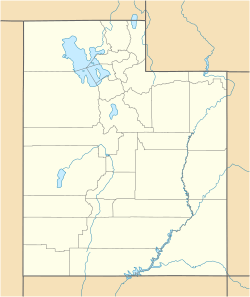Russian Settlement, Utah facts for kids
Quick facts for kids
Russian Settlement
|
|
|---|---|
| Country | United States |
| State | Utah |
| County | Box Elder |
| Established | April 1914 |
| Abandoned | 1917 |
| Elevation | 4,850 ft (1,480 m) |
Russian Settlement is a ghost town in Box Elder County, Utah, United States. A ghost town is a place where everyone has left. No one knows the real name the settlers gave their community. People sometimes call it "Box Elder County's ghost town with no name."
This small town existed for only a few years, from about 1914 to 1917. It was started by a group of people from Russia. They were called Molokan Spiritual Christians. The town failed quickly. This was because the company that sold them the land made it sound much better than it was. The company also did not provide things they promised, like water systems. Today, the most important thing left is a cemetery with two graves.
Contents
History of Russian Settlement
Between 1910 and 1914, a company called Pacific Land and Water Company bought a lot of land. They owned about 180,000 acres (280 square miles) in Box Elder County. They wanted to sell this land to new settlers.
The company advertised this dry land as "amongst the richest in the state of Utah." They claimed it "only awaits the plow to yield up its vast treasures." They said the weather was "energizing." They even said that lots of sagebrush meant the soil was good for farming. Land was sold for $17.50 per acre. Buyers paid 20 percent down and the rest over five years.
Why the Settlers Came
In March 1914, about 20 men from Russia bought four square miles of this land. These men were Spiritual Christians, mostly a group called pryguny (Jumpers). They had lived in Los Angeles, California, for about ten years. The older people worried about how American city life was changing their youth. They wanted their children to grow up with their own language, culture, and traditions. They also wanted to keep their custom of arranged marriages.
The families, about 100 to 125 people, traveled by train. They went from Los Angeles to Kelton, Utah. In April 1914, a company employee took them by wagon to their new town site.
Building the Village
The settlement was planned like villages in the Russian Empire. A main street ran from east to west through the center of town. Each lot was a three-acre strip of land. It had 200 feet of space along the main road.
The settlers built houses, barns, and root cellars. They got lumber from a sawmill owned by the Pacific Land and Water Company. This sawmill was in the nearby Raft River Mountains. They bought animals from local ranchers and planted crops. Other small villages were also started by Molokan Spiritual Christians nearby.
By August 1914, there were 40 children old enough for school. Box Elder County decided to open a one-room school. They also provided a teacher. A portable school house was built on the west end of the main street. The teacher was one of the settlers. The land company paid the teacher. However, by November 1915, the school did not have enough students. The children then had to take a bus to a school in Rosette.
Farming Challenges
The immigrants bought 2,600 acres of land. Each family was supposed to get 80 acres outside of town for farming. But only one settler actually used this land. Most families farmed on their house lots. They grew only small gardens and plots of hay and grain.
The Pacific Land and Water Company had promised to build Irrigation wells and pumps. These were never delivered. So, most families had to water their crops using their home wells.
The Town's Decline
The crops failed many times. Because of this, people started leaving the town in 1915. By August 1916, the stove from the schoolhouse was moved to another school. In September, the entire school building was taken apart and moved. By the end of 1917, Russian Settlement was completely empty. It had become a ghost town.
Most of the settlers went back to the Los Angeles area. People from Box Elder County took the buildings apart. Some buildings were moved to new places. Others were taken apart for their materials.
What Remains Today
No one has lived in the area since the Russian settlers left. Some buildings stood for many years. The layout of the town lots could still be seen in the 1960s.
Today, the most important thing left is a white picket fence. It surrounds two graves. Both gravestones are written in Russian. One grave belongs to Anna Kalpakoff. She was accidentally shot by her husband. The other grave is for her sister-in-law, Mary Kalpakoff. Mary died while giving birth. New headstones were placed in 1966 by Mary's son and grandson.
You can also see clear foundations of old buildings. There are caved-in wells and different artifacts. In 1937, a cowboy on horseback fell into an old well here but managed to escape. A hill nearby is called Russian Knoll. This name honors the immigrants who once lived in this area.



